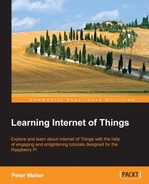In the previous chapters, we experimented with a lot of different technologies that can be used for Internet of Things (IoT), but we did not delve into details about security and interoperability issues to any extent. In this chapter, we will focus on this topic and what issues we need to address during the design of the overall architecture to avoid many of the unnecessary problems that might otherwise arise and minimize the risk of painting yourself into a corner. You will learn the following:
- Risks with IoT
- Modes of attacking a system and some counter measures
- The importance of interoperability in IoT
There are many solutions and products marketed today under the label IoT that lack basic security architectures. It is very easy for a knowledgeable person to take control of devices for malicious purposes. Not only devices at home are at risk, but cars, trains, airports, stores, ships, logistics applications, building automation, utility metering applications, industrial automation applications, health services, and so on, are also at risk because of the lack of security measures in their underlying architecture. It has gone so far that many western countries have identified the lack of security measures in automation applications as a risk to national security, and rightly so. It is just a matter of time before somebody is literally killed as a result of an attack by a hacker on some vulnerable equipment connected to the Internet. And what are the economic consequences for a company that rolls out a product for use on the Internet that results into something that is vulnerable to well-known attacks?
How has it come to this? After all the trouble Internet companies and applications have experienced during the rollout of the first two generations of the Web, do we repeat the same mistakes with IoT?
One reason for what we discussed in the previous section might be the dissonance between management and engineers. While management knows how to manage known risks, they don't know how to measure them in the field of IoT and computer communication. This makes them incapable of understanding the consequences of architectural decisions made by its engineers. The engineers in turn might not be interested in focusing on risks, but on functionality, which is the fun part.
Another reason might be that the generation of engineers who tackle IoT are not the same type of engineers who tackled application development on the Internet. Electronics engineers now resolve many problems already solved by computer science engineers decades earlier. Engineers working on machine-to-machine (M2M) communication paradigms, such as industrial automation, might have considered the problem solved when they discovered that machines could talk to each other over the Internet, that is, when the message-exchanging problem was solved. This is simply relabeling their previous M2M solutions as IoT solutions because the transport now occurs over the IP protocol. But, in the realm of the Internet, this is when the problems start. Transport is just one of the many problems that need to be solved.
The third reason is that when engineers actually re-use solutions and previous experience, they don't really fit well in many cases. The old communication patterns designed for web applications on the Internet are not applicable for IoT. So, even if the wheel in many cases is reinvented, it's not the same wheel. In previous paradigms, publishers are a relatively few number of centralized high-value entities that reside on the Internet. On the other hand, consumers are many but distributed low-value entities, safely situated behind firewalls and well protected by antivirus software and operating systems that automatically update themselves. But in IoT, it might be the other way around: publishers (sensors) are distributed, very low-value entities that reside behind firewalls, and consumers (server applications) might be high-value centralized entities, residing on the Internet. It can also be the case that both the consumer and publisher are distributed, low-value entities who reside behind the same or different firewalls. They are not protected by antivirus software, and they do not autoupdate themselves regularly as new threats are discovered and countermeasures added. These firewalls might be installed and then expected to work for 10 years with no modification or update being made. The architectural solutions and security patterns developed for web applications do not solve these cases well.
When you decide to move into a new neighborhood, it might be a good idea to know your neighbors first. It's the same when you move a M2M application to IoT. As soon as you connect the cable, you have billions of neighbors around the world, all with access to your device.
What kind of neighbors are they? Even though there are a lot of nice and ignorant neighbors on the Internet, you also have a lot of criminals, con artists, perverts, hackers, trolls, drug dealers, drug addicts, rapists, pedophiles, burglars, politicians, corrupt police, curious government agencies, murderers, demented people, agents from hostile countries, disgruntled ex-employees, adolescents with a strange sense of humor, and so on. Would you like such people to have access to your things or access to the things that belong to your children?
If the answer is no (as it should be), then you must take security into account from the start of any development project you do, aimed at IoT. Remember that the Internet is the foulest cesspit there is on this planet. When you move from the M2M way of thinking to IoT, you move from a nice and security gated community to the roughest neighborhood in the world. Would you go unprotected or unprepared into such an area? IoT is not the same as M2M communication in a secure and controlled network. For an application to work, it needs to work for some time, not just in the laboratory or just after installation, hoping that nobody finds out about the system. It is not sufficient to just get machines to talk with each other over the Internet.
